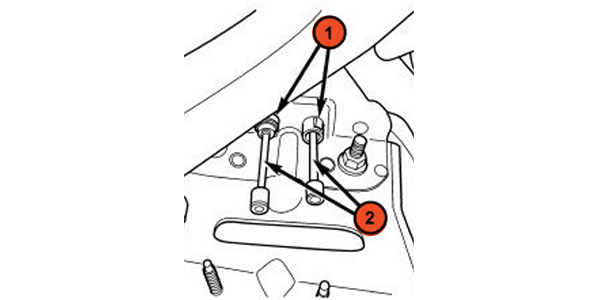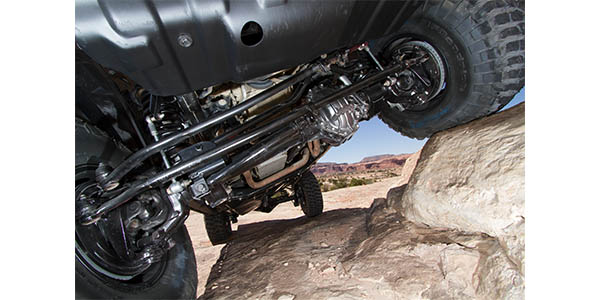
The Jeep Wrangler JK can be deceiving. If you look at the brake pads, rotors and calipers, it looks like just about every other truck. When you look at the front and rear suspension, it looks dated with a front live axle. But, don’t underestimate the JK because it has one of the most hydraulically sophisticated ABS and stability control systems on the market.
Brake Pads
With the Jeep Wrangler, you need to find out how the customer uses their Jeep. If the vehicle spends the majority of its life on the asphalt, go with a pad that matches the original brake pad for cold and hot friction levels. If the Jeep spends time rock crawling or on trails, there are pads that have higher levels of friction when the brakes are cold.
Never go with a sub-standard brake pad. The brake pad for the JK is the foundation of the stability control system. If the customer has a larger wheel and tire package that increases the diameter or adds weight to the wheel assembly, the pads and rotors will have to work harder to stop.
Rotors
The brake rotors are adequate for the JK platform with ventilated rotors in the front and solid rotors in the rear. But, don’t take pulsation and runout lightly for the JK. Even with solid axles, the factory specification for all the years is around 0.002.”


Parking Brake
The JK uses a drum inside the hat of the rotor for the parking brake. It is not a self-adjusting mechanism; the parking brake adjustment for the cables is under the center console. The secret is to lock the lever into the service position and adjust the cables at the equalizer bar.

ABS and Stability Control
On paved roads, the live axles and high center of gravity become a liability. The ABS and stability control system are essential for the ancient Jeep suspension to keep the vehicle stable under emergency maneuvers. But, the JK’s Hydraulic Control Unit (HCU) does a lot more.
The Electronic Stability Control (ESC) may also be referred to as Electronic Stability Program (ESP), depending on the vehicle model year and configuration. Certain components may also reference ESP, ESC or use the traction control symbol.
The ESC system uses sensors in the Jeep JK to determine the vehicle path intended by the driver and compares it to the actual path of the vehicle. When the actual path does not match the intended path, ESC applies the brake of the appropriate wheel to assist in counteracting oversteer or understeer conditions.
The sensors used by the system are the Dynamic Sensor, steering angle sensor and the wheel speed sensors. The Dynamic Sensor is mounted under the center console and measures side-to-side (lateral) motion and vehicle rotation (yaw). It must be calibrated if it is disturbed or replaced. The system also uses inputs from the brake and accelerator pedal to determine a correction. Also, the HCU also uses information like the transmission gear and transfer case lever position.
BAS
The HCU also has a Brake Assist System (BAS). The system detects an emergency braking situation by sensing the rate and amount of brake application, and then uses the accumulators and motor inside the HCU to apply optimal pressure to the brakes in the event the driver hits the brakes hard as detected by the brake pedal switch and a pressure sensor in the HCU.
ERM
The Electronic Roll Mitigation (ERM) system monitors steering wheel input and the speed of the vehicle. When the rate of change of the steering wheel angle and vehicle’s speed are sufficient to potentially cause an inside wheel to lift, the appropriate brake will apply and engine power may be reduced to lessen the chance that wheel lift will occur. ERM will only intervene during very severe or evasive driving maneuvers.
HSA
Later JK models have Hill Start Assist (HSA). The system is designed to maintain the level of brake pressure for a short period of time after the brake pedal is released so that the vehicle does not roll on a hill between releasing the brake pedal and applying the accelerator pedal.
The following must be true for HSA to activate:
• The vehicle must be stopped with the brake applied.
• The vehicle must be at an eight percent or greater incline (three percent for manual transmissions).
• Gear selection must match uphill direction (forward gear for uphill, reverse for backing uphill).
TSC
The Trailer Sway Control (TSC) system uses the Dynamic Sensor to recognize an excessively swaying trailer and will take the appropriate actions to attempt to stop the sway. The system may reduce engine power and apply the brake of the appropriate wheel(s) to counteract the sway of the trailer. TSC will become active automatically once an excessively swaying trailer is recognized.
HDC
The Hill Descent System (HDC) system maintains vehicle speed while the vehicle is descending hills in off-road driving conditions by applying the brakes when necessary at low speeds. HDC can only be enabled when the transfer case is in the “4WD LOW” position and the vehicle speed is less than 30 mph. If these conditions are not met while attempting to use the HDC feature, the HDC indicator light will flash on/off. The HDC indicator lamp will be on solid when HDC is enabled. The accelerator pedal will override HDC at any time.
The Jeep Wrangler JK was replaced this year by the JL. The brake system is very similar to the JK, but with new front caliper options. With these systems, the mechanical components have a direct affect on the electronic operation of the system. This is why a proper brake service is necessary.













